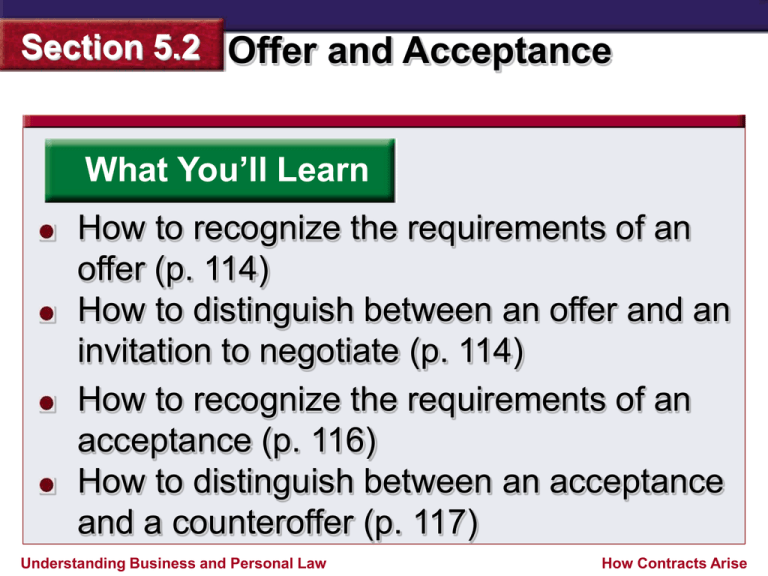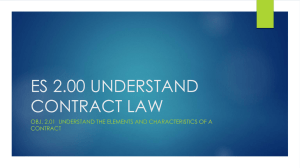Section 5.2 Assessment Understanding Business and Personal Law
advertisement

Section 5.2 Offer and Acceptance What You’ll Learn How to recognize the requirements of an offer (p. 114) How to distinguish between an offer and an invitation to negotiate (p. 114) How to recognize the requirements of an acceptance (p. 116) How to distinguish between an acceptance and a counteroffer (p. 117) Understanding Business and Personal Law How Contracts Arise Section 5.2 Offer and Acceptance What You’ll Learn How to recognize when an offer has terminated (p. 119) Why It’s Important You need to know when an offer has been made and when an acceptance goes into effect to make sound contracts. Understanding Business and Personal Law How Contracts Arise Section 5.2 Offer and Acceptance Section Outline Requirements of an Offer Serious Intent Definiteness and Certainty Communication to the Offeree Requirements of an Acceptance Unconditional Acceptance Methods of Acceptance Understanding Business and Personal Law How Contracts Arise Section 5.2 Offer and Acceptance Section Outline Termination of an Offer Revocation Rejection Counteroffer Expiration of Time Death or Insanity Understanding Business and Personal Law How Contracts Arise Section 5.2 Offer and Acceptance Requirements of an Offer The person who makes an offer is the offeror. The person who receives the offer is the offeree. An offer has three basic requirements. It must be: 1. Made seriously 2. Definite and certain 3. Communicated to the offeree Understanding Business and Personal Law How Contracts Arise Section 5.2 Offer and Acceptance Serious Intent An offer must be made with the intention of entering into a legal obligation. An offer made in the heat of anger or as a joke would not meet this requirement. Understanding Business and Personal Law How Contracts Arise Section 5.2 Offer and Acceptance Serious Intent Sometimes an invitation to negotiate can be confused with an offer. Advertisements in newspapers, magazines, and catalogs are examples of invitations to negotiate, which are invitations to make an offer. Understanding Business and Personal Law How Contracts Arise Section 5.2 Offer and Acceptance Definiteness and Certainty An offer must be definite and certain to be enforceable. Offers that use vague words or terms that cannot be quantified lack definiteness and certainty. Understanding Business and Personal Law How Contracts Arise Section 5.2 Offer and Acceptance Communication to the Offeree Offers may be made by any method that communicates the offer to the offeree, including: Telephone Fax machine Letter E-mail Telegram Understanding Business and Personal Law How Contracts Arise Section 5.2 Offer and Acceptance Pre-Learning Question Is a counteroffer the same thing as an acceptance? Why or why not? Understanding Business and Personal Law How Contracts Arise Section 5.2 Offer and Acceptance Requirements of an Acceptance To be legally binding, the acceptance must meet certain basic requirements. The acceptance must be unconditional. The acceptance must follow the rules regarding the method of acceptance. Understanding Business and Personal Law How Contracts Arise Section 5.2 Offer and Acceptance Unconditional Acceptance The acceptance must not change the terms of the original offer in any way. This principle is called the mirror image rule. Any change in the terms of the offer means the offeree has not really accepted the offer. The offeree has made a counteroffer. Understanding Business and Personal Law How Contracts Arise Section 5.2 Offer and Acceptance Unconditional Acceptance If a counteroffer is made, the original offeror is not obligated to go along and no contract exists. The offeror becomes an offeree and may accept or reject the counteroffer. Contracts for the sale of goods are exceptions to the mirror image rule. These exceptions include contracts for personal property such as clothing, furniture, food, motor vehicles, and appliances. Understanding Business and Personal Law How Contracts Arise Section 5.2 Offer and Acceptance Methods of Acceptance The time at which an acceptance takes place is important because that is when the contract comes into existence. Special rules govern acceptances that take place when the parties are separated by a distance and must be communicated by letters, telegrams, or fax. Understanding Business and Personal Law How Contracts Arise Section 5.2 Offer and Acceptance Methods of Acceptance According to common law, an acceptance that must be sent over long distances is effective when it is sent. An acceptance is implied when the offeree accepts by the same or a faster means than that used by the offeror. Understanding Business and Personal Law How Contracts Arise Section 5.2 Offer and Acceptance Methods of Acceptance The authorization of an acceptance can also be implied by any reasonable means, including: Past practices between the parties The usual method in the trade Customary means in comparable transactions Understanding Business and Personal Law How Contracts Arise Section 5.2 Offer and Acceptance Termination of an Offer Termination of an offer may occur in any of the following five ways: 1. Revocation 2. Rejection 3. Counteroffer 4. Expiration of time 5. Death or insanity Understanding Business and Personal Law How Contracts Arise Section 5.2 Offer and Acceptance Revocation Revocation is the taking back of an offer by the offeror. Rejection Rejection, or refusal, of an offer by the offeree brings the offer to an end. Understanding Business and Personal Law How Contracts Arise Section 5.2 Offer and Acceptance Counteroffer A counteroffer ends the first offer. The offeree creates a new offer, which the original offeror may accept or reject. Expiration of Time If the offeror sets a time limit for the acceptance of the offer, it must be honored. Understanding Business and Personal Law How Contracts Arise Section 5.2 Offer and Acceptance Death or Insanity If the offeror dies or becomes insane before the offer is accepted, the offer comes to an end. Understanding Business and Personal Law How Contracts Arise Section 5.2 Offer and Acceptance Section 5.2 Assessment Reviewing What You Learned 1. What are the requirements of an offer? Understanding Business and Personal Law How Contracts Arise Section 5.2 Offer and Acceptance Section 5.2 Assessment Reviewing What You Learned Answer Serious intent, clear and definite terms, and communication to the offeree. Understanding Business and Personal Law How Contracts Arise Section 5.2 Offer and Acceptance Section 5.2 Assessment Reviewing What You Learned 2. What is the difference between an offer and an invitation to negotiate? Understanding Business and Personal Law How Contracts Arise Section 5.2 Offer and Acceptance Section 5.2 Assessment Reviewing What You Learned Answer An offer empowers the offeree to accept its terms and create a contract. An invitation to negotiate is an invitation to the other party to make an offer. Understanding Business and Personal Law How Contracts Arise Section 5.2 Offer and Acceptance Section 5.2 Assessment Reviewing What You Learned 3. What are the requirements of an acceptance? Understanding Business and Personal Law How Contracts Arise Section 5.2 Offer and Acceptance Section 5.2 Assessment Reviewing What You Learned Answer Must be unconditional and must follow the rules regarding the method of acceptance. Understanding Business and Personal Law How Contracts Arise Section 5.2 Offer and Acceptance Section 5.2 Assessment Reviewing What You Learned 4. What is the difference between an acceptance and a counteroffer? Understanding Business and Personal Law How Contracts Arise Section 5.2 Offer and Acceptance Section 5.2 Assessment Reviewing What You Learned Answer An acceptance creates a contract. A counteroffer means that the original offer has not been accepted. The offeree has made a new offer, which the original offeror may accept or reject. Understanding Business and Personal Law How Contracts Arise Section 5.2 Offer and Acceptance Section 5.2 Assessment Reviewing What You Learned 5. When is an offer terminated? Understanding Business and Personal Law How Contracts Arise Section 5.2 Offer and Acceptance Section 5.2 Assessment Reviewing What You Learned Answer Upon revocation by the offeror, on rejection by the offeree, when a counteroffer is made, after the expiration of a set period of time, and/or the death or insanity of the offeror. Understanding Business and Personal Law How Contracts Arise Section 5.2 Offer and Acceptance Section 5.2 Assessment Critical Thinking Activity Identifying an Offer Why is it important to be able to distinguish between an offer and an invitation to negotiate? Understanding Business and Personal Law How Contracts Arise Section 5.2 Offer and Acceptance Section 5.2 Assessment Critical Thinking Activity Answer Identifying an Offer Answers will vary, but should recognize that by understanding the difference between the two; a buyer won’t confuse an advertisement with an offer. Understanding Business and Personal Law How Contracts Arise Section 5.2 Offer and Acceptance Section 5.2 Assessment Legal Skills in Action Invitations to Negotiate Tina believes that she can compel a used car dealership to sell her a car that was advertised in the newspaper. She believes the advertisement is an offer that she intends to accept tomorrow. Understanding Business and Personal Law How Contracts Arise Section 5.2 Offer and Acceptance Section 5.2 Assessment Legal Skills in Action Invitations to Negotiate Write a paragraph that explains why advertisements in a newspaper are considered invitations to negotiate rather than offers. Understanding Business and Personal Law How Contracts Arise Section 5.2 Offer and Acceptance Section 5.2 Assessment Legal Skills in Action Answer Invitations to Negotiate Answers will vary, but should explain that sellers usually have limited merchandise to sell and cannot possibly sell an advertised product to everyone who sees an ad. Understanding Business and Personal Law How Contracts Arise SECTION OPENER / CLOSER: INSERT BOOK COVER ART End of Section 5.2 Offer and Acceptance






